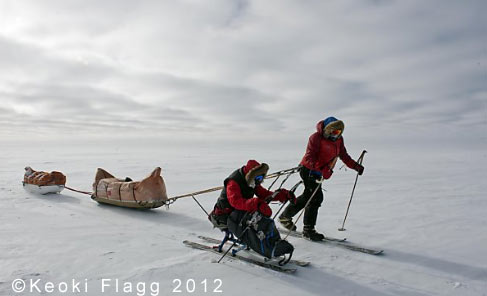I’m not sure what I think about the ascendance of the adaptive athlete. On the one hand, I’m truly inspired by these guys. On the other hand, I sometimes get the feeling that cutting of an arm or a leg could be a good career move. In any case, the latest stunner is Grant Korgan. He made 250,000 pole pushes on his sitski to be the first such athlete to reach the South Pole. To top off the PR value, Korgan timed his “pole to the pole” arrival to coincide with 100th anniversary of Captain Scott’s ill fated South Pole visit in 1912. The documentary film and TV series are of course following. Check it out.

Pole to the South Pole. Grant Korgan making one of 250,000 pole plants that got him there.
Out here in the cowboy hatted west of the U.S., we’ve still got a snowpack in many places that resembles a minefield. A couple of avalanche deaths near here in Colorado bring that home. Close calls have happened as well. Up at our local haunt near Marble, a group of cowboys that I’ve heard called the “wrecking crew” triggered fully three separate slides down towards themselves within just a few minutes. I’m told one man was wallowing with a lost ski in the direct path of a death ride. Why the slides stopped where they did (I went up there and took a look) is probably a miracle — as is the type of washing machine that will be required for this individual’s underwear. A backcountry snowboarder in Utah wasn’t so lucky, and took a huge ride to his death this past Saturday.
We were out this weekend checking the minefield. With my eyelids pinned back so my avy retinas could stay fully engaged, I was stunned at how bad the snowpack actually was. Unfortunately, the worst aspect in the area I evaluated is that much of the snow is still hanging in the avalanche paths and has not come down. Enough smaller pocket slides had occurred to prevent gigantic full-path avalanches in the paths we passed underneath, but actually skiing anything still in those paths would have been suicidal. Basically, the snowpack is super inconsistent. Some areas have up to a meter of loose sugar snow “facets” with multiple slab layers sitting on top. Other areas are so thin you can see the weeds. With fat skis, you can pass over and even have fun skiing the minimal “bridging” the top layers provide, thus not realizing the facet layers are waiting under there to suddenly compress from your weight, then trigger an avalanche comprising the poorly bonded and minimally bridged upper layers. In all, ridiculous. Our snowpack will heal, but it may take weeks and bad areas could linger long after that — even extending into the spring season.
Ah, yes, and then we have snowmobilers vs skiers. It’s the issue that won’t go away — and probably shouldn’t till it is resolved. I still believe that some of the opposition to snowmobilers sharing non-wilderness terrain with skiers is based more on philosophical differences rather than true problems. But put too many of both groups in one small area, and reality does trump philosophy. As they say, the “sphere of influence” of one rabid powder-eating sledder is equal to dozens of human powered backcountry skiers. Thus, get a half dozen sledders funning your favorite backcountry skiing haunt, and they can completely trash in a few hours what would take your band of merry skinners multiple days to track out.
As for snowmobilers intruding in legal Wilderness where they’re outlawed — they need to be stopped, period. The outlaw sledders who scofflaw their way though banned lands from Colorado to Washington are cutting their own throats and possibly screwing things up for backcountry skiers as well. Why? Because land managers (mainly USFS) have few tools to control the outlaws, and one tool is to make ever more Wilderness “buffer zones” that close easier to patrol access points. This in turn closes more land to the snowmachines — and, don’t forget, to hut building and skier/snowmobile hybrid access. Witness what’s going on up in Washington State. And check out this little tiff zone in Wyoming.
There you go, a bit of coffee break fodder for the big Monday.
WildSnow.com publisher emeritus and founder Lou (Louis Dawson) has a 50+ years career in climbing, backcountry skiing and ski mountaineering. He was the first person in history to ski down all 54 Colorado 14,000-foot peaks, has authored numerous books about about backcountry skiing, and has skied from the summit of Denali in Alaska, North America’s highest mountain.
